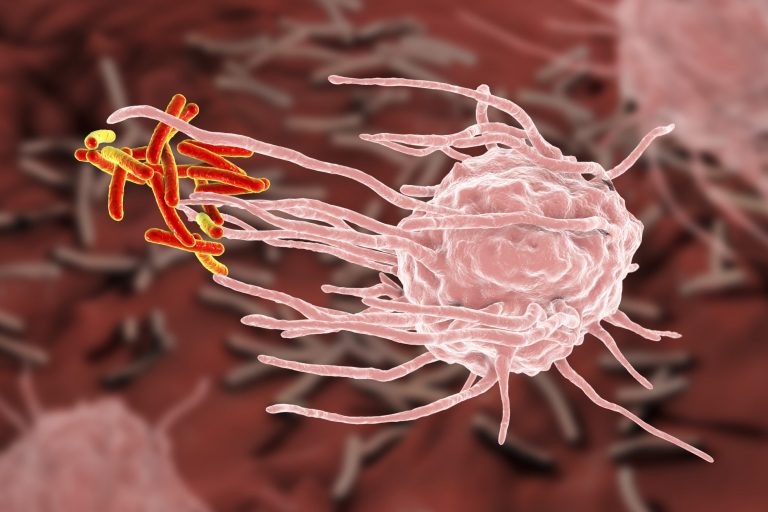Biological Cell Defense

A macrophage about to engulf the tuberculosis bacteria, “Mycobacterium tuberculosis” (3D illustration)
Table of Contents
Organisms must find a means of defense against antigens such a viruses described on the previous tutorial. If this was not the case, bacteria, fungi, and viruses would replicate out of control inside other organisms which would most likely already be extinct.
Therefore organisms employ many types of defense to stop this happening. Means of defense can be categorized into first and second lines of defense, with the first line usually having direct contact with the external environment.
First Lines of Defence
- Skin is an excellent line of defense because it provides an almost impenetrable biological barrier protecting the internal environment.
- Lysozyme is an enzyme found in tears and saliva that has powerful digestive capabilities, and can break down foreign agents to a harmless status before they enter the body.
- The clotting of blood near open wounds prevents an open space for antigens to easily enter the organism by coagulating the blood.
- Mucus and cilia found in the nose and throat can catch foreign agents entering these open cavities then sweep them outside via coughing, sneezing and vomiting.
- The cell wall of plants consists of fibrous proteins that provide a barrier to potential parasites (antigens).
If these first lines of defense fail, then there are further defenses found within the body to ensure that the foreign agent is eliminated.
Second Lines of Defense
Second lines of defense deal with antigens that have bypassed the first lines of defense and still remain a threat to the infected organism.
Interferons are a family of proteins that are released by a cell that is under attack by an antigen. These interferons attach themselves to receptors on the plasma membrane of other cells, effectively instructing it of the previous cells’ situation.
This tells these neighboring cells that an antigen is nearby and instructs them to begin coding for antiviral proteins, which upon action, defend the cell by shutting it down. In light of this, any invading antigen will not be able to replicate its DNA (or mRNA) and protein coat inside the cell, effectively preventing the spread of it in the organism. These antiviral proteins provide the organism with protection against a wide range of viruses.
This action brought about by interferon is a defensive measure, while white blood cells in the second line of defense in animals can provide a means of attacking these antigens.
One method of attacking antigens is by a method called phagocytosis, where the contents of the antigen are broken down by molecules called phagocytes.
These phagocytes contain digestive enzymes in their lysosomes (an organelle in phagocytes) such as lysozyme. White blood cells such as a neutrophil or a monocyte are capable of undergoing phagocytosis, which is illustrated below.

- The bacterium inside the cell gives out chemical messages that are picked up by the phagocyte.
- The bacteria target the cell as a possible host and moves towards it.
- The cell is prepared for this and the bacterium becomes trapped in a vacuole that forms around it.
- The bacterium is a sitting duck that is harmless at present.
- The lysosomes detect the bacterium and the digestive enzymes inside them begin to break the bacterium down.
- The remnants of the lysosome and bacterium materials are absorbed into the cytoplasm.
The above illustrates one method of ridding an organism of an internal threat caused by an antigen. This is a non-specific response to an antigen. The next tutorial looks at specific immunity and focuses on plant defenses.
You will also like...

Sigmund Freud and Carl Gustav Jung
In this tutorial, the works of Carl Gustav Jung and Sigmund Freud are described. Both of them actively pursued the way h..

Principles of Hormonal Control Systems
Hormones are essential in the regulation of the activity of the various biological systems of the human body. The ineffi..

Soils
Nutrients in the soil are essential to the proper growth of a land plant. This tutorial deals with the properties of soi..

Genetics – Lesson Outline & Worksheets
Topics Modules Quizzes/Worksheets Description Introduction to Genetics Genetics – Definition: Heredity and ..

Lotic Communities & Algae
Lotic communities have conditions that are rather harsh for typical plants. Thus, the diversity of plant species in loti..

Fruits, Flowers, and Seeds
This tutorial deals with the structure and function of flowers, fruits, and seeds. Also included here are the types of f..
